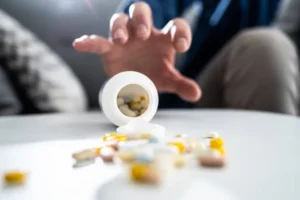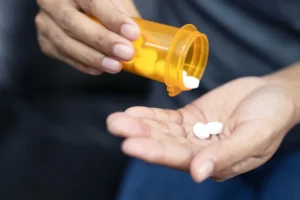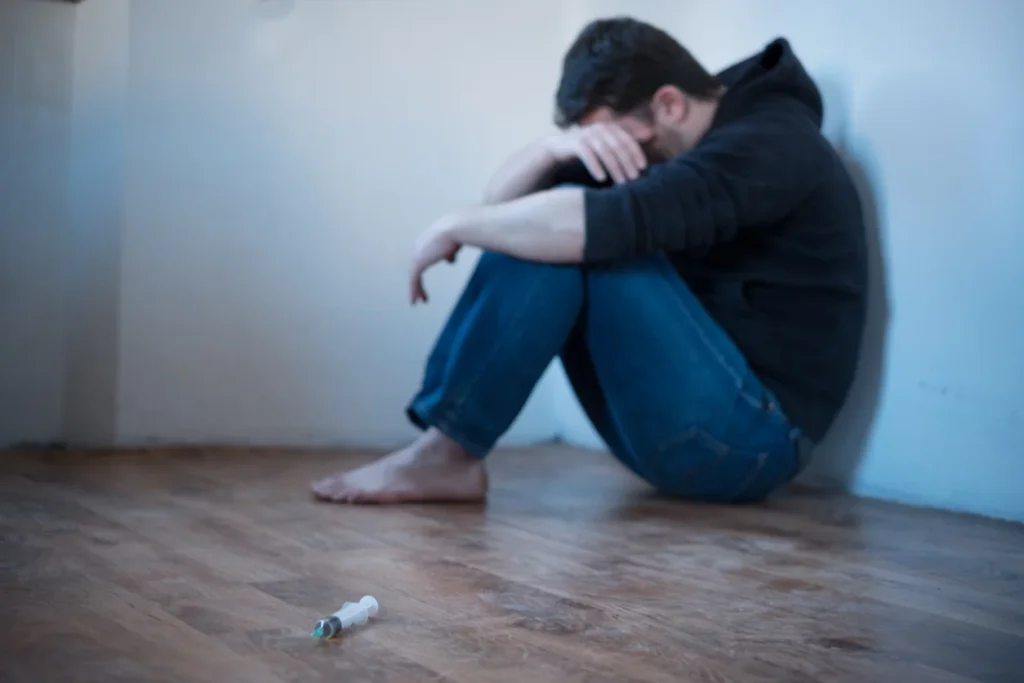Dealing with opiate withdrawal can be really tough because of the uncomfortable symptoms that come with it. But knowing the right ways to handle these symptoms can make a big difference.
In this blog, we’ll look at how to ease opiate withdrawal symptoms. We’ll talk about the best medications to use, some simple home remedies, and changes you can make in your daily life to help you feel better. We’ll also cover how therapy and support groups can keep you on track for the long haul.
So, let’s dive in and learn how to manage these challenges!
Contents
Understanding Opiate Withdrawal
 Opiate withdrawal is a challenging process that occurs when a person who has been regularly using opioids (like heroin, morphine, or prescription pain relievers) reduces or stops their use. The body, having become dependent on these substances to function normally, reacts when the drug is withheld.
Opiate withdrawal is a challenging process that occurs when a person who has been regularly using opioids (like heroin, morphine, or prescription pain relievers) reduces or stops their use. The body, having become dependent on these substances to function normally, reacts when the drug is withheld.
What Happens During Withdrawal?
When opioids are used consistently, the brain grows accustomed to their presence and adjusts its own chemistry to compensate. Opioids bind to receptors in the brain that regulate pain and emotions, increasing dopamine levels and creating feelings of euphoria and intense relaxation. Over time, the brain produces fewer neurotransmitters related to pleasure and well-being, relying more on the drug to stimulate these feelings.
Typical Symptoms of Opiate Withdrawal
Withdrawal symptoms can begin as early as a few hours after the last dose and might include:
- Physical Symptoms: Sweating, racing heart, muscle aches, trembling, nausea, vomiting, diarrhea, and dilated pupils.
- Emotional Symptoms: Anxiety, irritability, insomnia, depression, and strong cravings for the drug.
Timeline of Withdrawal Symptoms
 The timeline can vary based on the type of opioid used, the duration of use, and the individual’s overall health, but it generally follows this pattern:
The timeline can vary based on the type of opioid used, the duration of use, and the individual’s overall health, but it generally follows this pattern:
- Early Stages (6-12 hours for short-acting opiates, 30 hours for long-acting ones): Symptoms begin with muscle aches, sweating, agitation, and anxiety.
- Peak Symptoms (1-3 days): This period is the most uncomfortable, with peak symptoms like vomiting, diarrhea, shaking, and intense cravings.
- Subsiding Phase (1 week): While acute symptoms decrease, some lingering effects such as reduced appetite, mood swings, and disturbed sleep patterns may persist for a few weeks.
Understanding the nature of opiate withdrawal and its symptoms is crucial for those preparing to detox and for their support networks. Recognizing what to expect can help manage the process more effectively and seek appropriate help to reduce the severity of symptoms and support recovery.
Medications Used in Opiate Withdrawal
 Managing opiate withdrawal effectively often involves the use of specific medications that help alleviate symptoms and stabilize the body. Here’s a look at some of the most commonly used medications:
Managing opiate withdrawal effectively often involves the use of specific medications that help alleviate symptoms and stabilize the body. Here’s a look at some of the most commonly used medications:
- Methadone
It is a long-acting opioid agonist that binds to the same receptors in the brain as other opiates like heroin and morphine. By activating these receptors, methadone helps to reduce cravings and withdrawal symptoms without producing the high associated with other opioids. - Buprenorphine
Buprenorphine is a partial opioid agonist, which means it activates opioid receptors in the brain, but to a lesser extent than full agonists like heroin or methadone. This property allows it to help ease withdrawal symptoms while lowering the risk of misuse, dependency, and side effects. - Clonidine
Clonidine is not an opioid; instead, it is an alpha-2 adrenergic agonist that helps to reduce the “fight or flight” response, which is often heightened during withdrawal. Clonidine can help alleviate symptoms like anxiety, agitation, muscle aches, sweating, and cramping.
Home Remedies for Managing Symptoms
 While medical treatment is crucial for managing opiate withdrawal, certain home remedies and over-the-counter aids can also help alleviate milder symptoms. These can be particularly useful for managing discomfort at home during the detox process.
While medical treatment is crucial for managing opiate withdrawal, certain home remedies and over-the-counter aids can also help alleviate milder symptoms. These can be particularly useful for managing discomfort at home during the detox process.
- Stay Hydrated: Drink plenty of water, herbal teas, and electrolyte-replenishing beverages to prevent dehydration.
- Eat Nutritious Foods: Focus on light, easy-to-digest meals like soups, broths, yogurt, and fruits.
- Use Over-the-Counter Medications: Consider OTC remedies for nausea (like meclizine), diarrhea (like loperamide), and pain relief (such as acetaminophen or ibuprofen).
- Warm Baths: Soak in a warm bath to help relieve muscle aches and calm the nerves.
- Create a Comfortable Environment: Ensure your resting area is quiet, dark, and comfortable. Use pillows and blankets to make yourself as comfortable as possible.
- Practice Relaxation Techniques: Engage in deep breathing exercises, meditation, or gentle yoga to reduce stress and anxiety.
- Engage in Light Physical Activity: If possible, try gentle walking or stretching to boost mood and reduce tension.
- Maintain a Routine: Try to keep a regular schedule for eating, sleeping, and activities to bring structure to your day.
- Avoid Triggers: Stay away from environments or social situations that could tempt you to use substances.
- Seek Support: Stay in touch with supportive friends, family, or support groups who can provide encouragement and understanding during this challenging time.
Implementing these strategies can help alleviate some of the discomfort associated with opiate withdrawal and support the body’s recovery process.
The Role of Therapy in Opiate Recovery

Therapy plays a crucial role in the recovery process from opiate addiction, providing essential support that addresses the psychological underpinnings of substance use and helping individuals develop strategies for long-term sobriety.
Cognitive Behavioral Therapy (CBT)
- Purpose: CBT is designed to help individuals recognize and change negative thoughts and behaviors that contribute to addiction.
- How It Works: Through CBT, individuals learn to identify triggers that lead to drug use, develop coping strategies to deal with these triggers, and correct problematic thinking that might lead to substance abuse. For example, CBT can help someone understand that stress from work doesn’t need to result in opiate use but can be managed through healthier methods such as exercise or meditation.
- Benefits: CBT provides practical tools for managing stress and anxiety and helps prevent relapse by teaching effective relapse prevention techniques.
Motivational Interviewing (MI)
- Purpose: MI is a client-centered, directive method aimed at enhancing intrinsic motivation to change by exploring and resolving ambivalence.
- How It Works: This approach involves the therapist acting as a facilitator who helps the individual understand their own reasons for change. In the context of opiate recovery, MI helps individuals find personal motivations to stay clean, such as improving relationships or achieving personal goals.
- Benefits: MI is particularly effective in helping individuals overcome the initial resistance to treatment and can support engagement and adherence to other therapeutic interventions.
Integrated Treatment Approach
- Combining Therapies: Often, CBT and MI are used together in an integrated treatment plan that maximizes the strengths of both approaches. This combination can be particularly potent, with MI preparing individuals to engage in the more structured tasks of CBT.
- Holistic Recovery: These therapies are often part of a broader treatment program that includes medical detox, medication management, and support groups, providing a comprehensive approach to recovery.
By addressing both the behaviors and thought patterns that contribute to addiction, as well as enhancing motivation to change, therapy can be a powerful tool in the recovery journey. It not only helps manage withdrawal but also supports long-term recovery goals, making it an essential component of effective opiate addiction treatment.
Lifestyle Changes to Aid Recovery
 Adopting healthy lifestyle changes is a vital part of supporting recovery from opiate addiction. These changes can help improve both physical health and emotional well-being, making it easier to manage withdrawal symptoms and reduce the risk of relapse. Here are some key lifestyle changes that can aid in the recovery process:
Adopting healthy lifestyle changes is a vital part of supporting recovery from opiate addiction. These changes can help improve both physical health and emotional well-being, making it easier to manage withdrawal symptoms and reduce the risk of relapse. Here are some key lifestyle changes that can aid in the recovery process:
- Regular Exercise
Include activities like walking, jogging, yoga, or swimming into your daily routine. - Healthy Diet
Eat balanced meals that include a variety of fruits, vegetables, lean proteins, and whole grains. Avoid high-sugar and high-fat foods. - Adequate Sleep
Aim for 7-9 hours of quality sleep per night. Establish a regular sleep schedule, and create a restful sleeping environment free from distractions. - Hydration
Drink at least 8 glasses of water a day, and limit caffeine and alcohol intake, which can dehydrate the body. - Stress Management
Practice mindfulness meditation, deep breathing exercises, or engage in hobbies that help relieve stress. - Social Connections
Spend time with supportive family and friends, or join support groups where you can connect with others facing similar challenges.
Implementing these lifestyle changes can significantly enhance the effectiveness of clinical treatments and support long-term recovery by building a healthier, more balanced life.
Get Help For Opiate Withdrawal
Overcoming opiate withdrawal is a challenging journey, but you don’t have to face it alone. Effective support and professional treatment can significantly ease the process and increase your chances of successful recovery.
At QuitMantra, we understand the complexities of opiate withdrawal and recovery. Our comprehensive deaddiction programs are designed to support you through every step of the process:
Take the First Step Today
Don’t let addiction define your life. Whether you are struggling with addiction or dependency, we are here to help you regain control of your life and start on the path to a healthier future.
Visit QuitMantra today to book your trial therapy session or join our deaddiction program.
